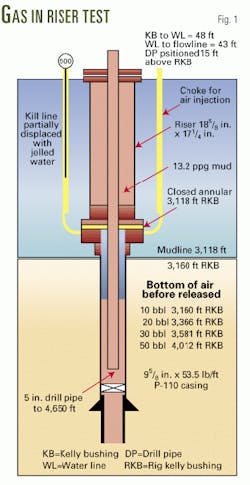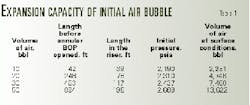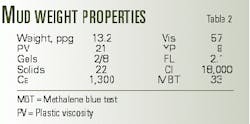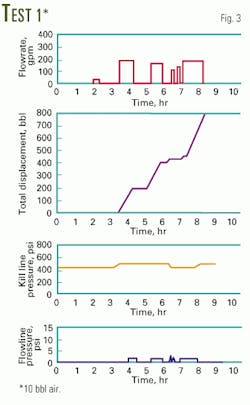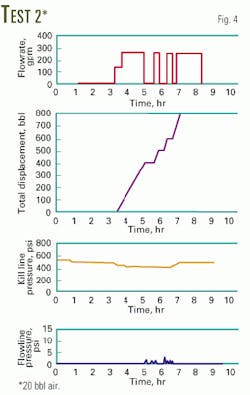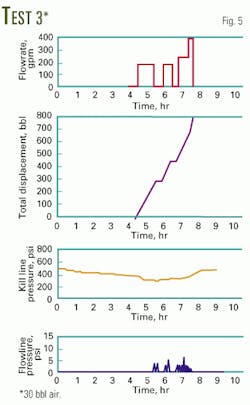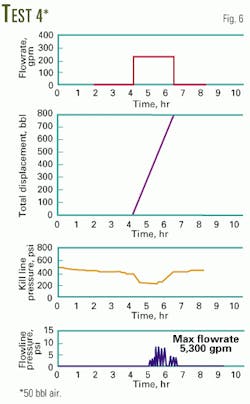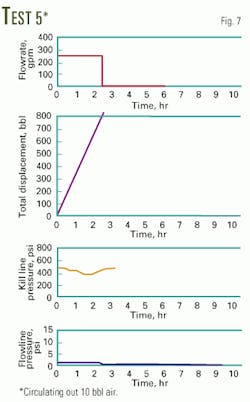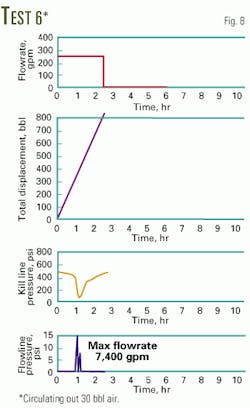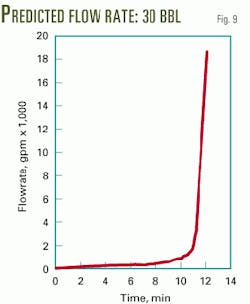This article on gas-bubble behavior in deepwater drilling risers provides some of the first published results concerning the dispersive behavior of gas in water-base mud.
Field tests conducted by three major operators show that gas-bubble formation in deepwater drilling risers, filled with water-base mud, is governed through dispersion rather than slug-type behavior patterns.
The dynamic effects of gas-bubble formation within marine risers pose major potential problems for offshore drilling operations in regards to well-control procedures and conditions that may possibly lead to collapsed risers.
To investigate the problem, Shell Offshore Inc., with participation by former Amoco Corp. (now part of BP Amoco PLC), and Exxon Corp. (now part of ExxonMobil Corp.), conducted field tests Mar. 5-7, 1986.
The tests, performed on OCS-G-6893 Well No. 2 in 3,118 ft of water (Viosca Knoll Block 912), consisted of releasing 10, 20, 30, and 50 bbl of air trapped below the annular blowout preventor (BOP) into a 171/4-in. ID riser containing 13.2-ppg mud.
Contrary to unpublished shallow-water field experiences (1,000 ft) and laboratory tests that indicated gas volumes can potentially rise as a slug,1 the companies found that air does not migrate and displace large volumes of mud from the riser in deepwater, water-base mud environments.
Instead, on each test, it was found that air dispersed throughout the riser and that the rig diverter systems in place adequately handled the gas migration. The tests, run while temporarily abandoning the well, were conducted in calm weather with essentially no rig heave.
Gas entry
Gas can enter the riser when:
- Drilling a gas sand proceeds too rapidly.
- Gas becomes trapped in the subsea BOP between the choke line and annular BOP after a gas kick is circulated.
- Operators fail to close the BOP until after a gas influx has migrated above the subsea BOP.
This condition can occur from difficulties in recognizing a kick on a floating rig, especially in rough weather. Additionally, the rapid gas migration from shallow reservoirs to the subsea BOP may occur within a very short time, causing response time difficulties.
In reaction to the theoretical pressures on the diverter system by gas in the riser, the industry has considered modifying the riser slip-joint packer and diverter systems to hold pressure.
Additionally, much thought has been given to installing an annular type close-in BOP under the slip joint to allow riser circulation under pressure.2
Test procedure
A 7-in. liner was set to isolate the open hole, while an EZSV retainer was run above the liner top. For the test, 5-in. drill pipe was run to 4,650 ft. The casing consisted of 95/8 in., 53.5 lb/ft P-110 tubulars (Fig. 1).
Air was injected down the choke line, while mud returns from the open-ended drill pipe were collected in the trip tank. Table 1 lists the four volumes of air used, length of the bubble before the annular was opened, length of the initial volume in the riser, initial pressure of the bubble, and volume of the air at atmospheric conditions.
After the desired amount of air was placed below the BOP, the lower choke valve was closed. The choke line was left pressured up with air between tests to save air injection time.
Before the tests began, the 13.2-ppg mud in the kill line was partially displaced with gelled water with the annular BOP kept open as returns were circulated to the surface.
This resulted in a U-tube pressure of 500 psi on the surface kill line. The objective was to monitor the change in pressure and calculate the change in the level of mud in the riser.
The lower kill-line valve was left closed during air injection and for 10 min after the annular was opened. Table 2 shows the mud-weight and properties.
Air, a good substitute for methane, was used in the test. Henry's Law describes the solubility of gases in water with methane becoming about twice as soluble in water as air. Additionally, the solubilities of both air and methane in water are low.
Therefore, air in water-base mud should effectively model the results that would otherwise be seen with methane in a real well.
It is important to note that these results cannot be correlated to oil-base mud where gas solubility is high.
Transocean Offshore Inc.'s Discoverer Seven Seas (now Transocean Sedco Forex Inc.) was well suited for the tests. The rig was equipped with 3,000-psi air compressors used for injecting air into the air-can riser.
Additionally, the rated collapse for the 185/8 x 171/4 in. FG-70 riser could withstand complete evacuation in a water depth of 3,118 ft. The riser volume was 825 bbl from the surface to the annular BOP.
Fig. 2 shows the diverter line. Pressure transducers accurate to within 0.5 psi were mounted in the 14-in. diverter line 20 ft from the diverter housing, 6 ft upstream of a 'T' connection that directs flow to the port or starboard.
The test results shown in Figs. 3-8 provide information on the time the annulus was opened vs. pump displacement flow rate, total mud displacement by pumps, kill line pressure, and flowline pressure.
Test No. 1: 10 bbl of air
After the annulus was opened, the well was observed for 3.6 hr. During this time, 7.7 bbl were pumped through the boost line to ensure the mud level was at the flowline. The migrating air never caused the well to flow.
The diverter was then opened and 200 bbl (25% of the riser volume) were circulated down the boost line with returns to the shaker. The pumps were stopped and the well underwent no flow.
The surface of the mud, however, appeared to be "boiling" with small bubbles of air breaking out of the mud. Surprisingly, no large slugs of air appeared, which otherwise would push mud into the flowline.
Next, an additional 200 bbl of mud were pumped and the returns were gas cut to 12.9 ppg from 13.2 ppg. Again, the well showed no signs of flow. Instead, the mud continued to boil as small bubbles broke out of the drill fluid.
The mud on the surface at this point was at about 1,500 ft below the flowline when the annulus released the trapped air.
Thus, the air bubbles migrated only 1,500 ft in 6.5 hr. As the remaining mud was circulated off bottom (bottoms up), the mud continued to bubble. Even the bottoms-up mud was gas cut.
Essentially, it appeared the air had been strung out throughout the riser. A 10-bbl bubble was obviously not large enough to migrate as a slug.
Test No. 2: 20 bbl of air
After release of the 20-bbl air bubble, the well was observed for 3.6 hr.; it would not unload. The well was then circulated. After 400 bbl, the pump was stopped to check for flow.
The mud continued to boil-and-bubble more than before, but the well would not flow. After pumping of 516 bbl of mud, the mud blew above the rotary. The diverter was closed, but the well did not continue to flow.
When the diverter was opened, the mud level was estimated at 25 ft down or about 6 bbl below the flowline. The remainder of bottoms-up fluid was circulated without the well ever slugging again. The mud was cut to 12.6 ppg before the slug.
The 6-bbl slug was the only time the well would flow on its own. It reached the surface 6 hr after the annular BOP was opened. Based on the volume of mud pumped, the slug had migrated only 1,000 ft. Again it appeared the air was strung out throughout the riser.
Test No. 3: 30 bbl of air
The well flowed immediately after the annular was opened when 30 bbl of air was released. Due to the length of the bubble (from the annular BOP at 3,118 ft RKB to 3,518 ft), it created higher pressures than the mud column above the annular BOP.
The bubble pressure was 2,437 psia. Therefore, the bubble must theoretically expand 4 bbl to balance the mud hydrostatic. The diverter was closed before opening the annular BOP. After flowing a small amount overboard, the well remained static for 4.3 hr.
Again, the well would boil or bubble but could not unload the mud. The well was then circulated for 221 bbl while the returns became gas cut at 12.4 ppg. Once again, when the pump was stopped, the well would not flow. The mud, however, did continue to boil more violently than in previous tests.
Another 33 bbl were pumped with the diverter opened. This was followed by gas-cut returns of 11.8 ppg. The diverter was then shut in, 103 bbl were circulated out, and the returns fell to 10.6 ppg. At this point, the well unloaded.
It took 33 bbl to fill the hole. During this test, a total of 357 bbl (1,350 ft of riser) had been circulated for 6.2 hr since the annular BOP was opened. Additionally, the air migrated a distance of 1,760 ft from the time annular BOP was opened. The well unloaded another slug of gas that required 19 bbl to fill the riser.
Test No. 4: 50 bbl of air
As it did when 30 bbl of air were released, the well flowed immediately when the annular BOP was opened with 50 bbl of trapped air. After the initial expansion balanced the bubble and mud pressures, the flow stopped.
The well was observed for 4 hr with no signs of flow. At this point, the well was circulated. After pumping 426 bbl of mud, the air unloaded the mud and the well flowed at an estimated peak rate of 5,300 gpm, based on a backpressure of 7 psi in the diverter line.
It required 76 bbl to bring the mud level back to the flowline. After an additional 118 bbl were pumped, the well unloaded 60 bbl of mud. After 15 bbl more were pumped, 34 bbl were unloaded. Then, 19 bbl were unloaded after 7 bbl more were pumped.
Additional flows of 4, 7, and 5 bbl were noted. The last small flow occurred after pumping 793 bbl. Therefore, gas was strung out throughout the entire length of the riser.
The first air bubble large enough to unload the well had migrated 1,500 ft in the 5.4 hr after the annular was opened.
Test No. 5: 10 bbl of air
The first four tests did not generate the anticipated results. The air was obviously getting strung out in the riser instead of migrating as a slug. Thus, for Test No. 5, it was decided to circulate out an air bubble as soon as the annulus was opened.
Immediately circulating the air bubble up might allow the bubble to remain intact so as to encounter slug conditions.
Nevertheless, the 10-bbl air bubble was circulated out without a slug effect. The mud was cut to 12.7 ppg at bottoms up, but the well did not unload any mud on its own. Thus, it appeared that mixing of the air bubbles took place during circulation. The 10-bbl bubble would become 38 ft long in the riser.
Test No. 6: 30 bbl of air
The final test included circulating out a 30-bbl bubble as soon as the annular BOP was opened. When a total of 419 bbl had been pumped, the well unloaded 202 bbl of mud.
The flow generated a 14-psi backpressure in the diverter line, equivalent to a 7,400-gpm flow rate. It is estimated that mud blew a distance of 60 ft from the rig. After pumping 42 bbl overboard, the well flowed an additional 30 bbl.
The 30 bbl of air were large enough to stay together and return to surface as a slug. The bubble would initially be 113 ft long in the riser, three times the length of the 10-bbl slug.
The largest bubble also surfaced after pumping had continued just over 1 hr. Thus, the bubble was not subject to break-up conditions for as long a time.
In shallower water, it may be more likely to see slug conditions as the gas returns to surface much more quickly.
Anticipated results
The tests were anticipated to produce high flow rates and relatively high pressures on the diverter. Laboratory work on bubble-rise velocity predicts a 30-bbl slug of air under the test conditions will migrate up the riser and cause the well to flow at rates exceeding 20,000 gpm, while generating a 60-psi backpressure on the flow line. Fig. 9 shows a theoretical plot of flow rate from the diverter line vs. time from opening of the annulus for a 30-bbl air bubble. Fig. 10 shows theoretical plot of the mud-pit gain due to the migrating air bubble.
The volume of the migrating bubble can be estimated by Boyles' Law, P1V1 = P2V2. Initially, the pressure in the bubble is determined by the amount of mud above it. Thus, as the bubble migrates half the distance to the surface, the pressure is halved and the volume doubles.
Therefore, the pressure in the bubble is determined by the mud above it and the back-flow pressure out the diverter line. The high flow rates are necessary to generate backpressure in a 14-in. line.
The peak flow rates and pressures would only last for seconds, but a failure of the diverter packer or diverter line would release a large gas volume onto or under the rig floor. The 30 bbl of air in Test No. 3 would expand to 7,460 bbl on the surface.
References
- Radar, D.W., Bourgoyne,A.T., Jr., and Ward, R.H., "Factors Affecting Bubble-Rise Velocity of Gas Kicks," Journal of Petroleum Technology, May 1975.
- Hall, J.E., and Roche, J.R., "Diverter for Deepwater Drilling Risers Permits Kick Control," OGJ, May 5, 1985.
The authors
Rome Gonzalez, a senior staff drilling engineer with Shell Offshore Inc., has held a variety of positions with the company over a 22-year period. More recently, he has worked on drilling systems design including those used on tension leg platforms. Gonzalez holds a BSCE from the University of Texas at El Paso.
John Shaughnessy has been a drilling engineer with BP Amoco for 22 years, primarily working drilling projects both onshore and offshore in the Gulf Coast area. He is currently working on the Tuscaloosa Trend in Louisiana. He holds a BS in chemical engineering from the University of Pittsburgh.
David Grindle is a 1975 graduate of the University of Alabama, Tuscaloosa, with a BS in Mineral Engineering. Over the past 25 years, he has held various engineering and management assignments with ExxonMobil Inc. affiliate drilling groups in the US and overseas. His involvement with deepwater drilling began in 1977 and covered operations in South America, the Gulf of Mexico, Australia, Egypt, and West of Britain. Since 1996, Grindle has held the position of procurement manager for drilling for ExxonMobil in Houston.
Insights into gas migration for deepwater risers
The following items provide insights into the problem of gas migration within drilling risers:
- Preplanned response procedures and the necessary patience to allow the gas to string out are two important factors to consider. Do not hurry to pump the riser out at a high rate.
- After a well-control event, prior to opening the subsea BOP, minimize the volume of gas that needs to be circulated up the marine riser by removing as much trapped gas as possible up a choke or kill line.
- The OCS-G-6893 Well No. 2 tests showed that even a large volume (up to 50 bbl) of trapped gas, situated in 3,100 ft of water, does not pose a mechanical risk to surface equipment when circulated out at low flow rates after allowing some time for dispersion.
- Only limited volume influxes were tested. Continuous gas feed into a marine riser, due to a BOP failure, has a low probability of occurring but will cause serious consequences if it does. Adequate equipment and procedures must be in place to detect and safely handle a leak in the BOP during well-control events.
- From the standpoint of high flow rates (velocities) and pressures, limited gas volumes do not appear to provide a high level of risk for equipment or personnel. However, proper equipment and procedures must be used to handle the flammable gases safely.
- Testing was performed in 3,118 ft of water. Varying the water depth may change the results. It is anticipated that in shallower water depths, the gas may not string out in the riser to the same degree as was seen in the tests. Also, mud viscosity and oil content will affect results.
